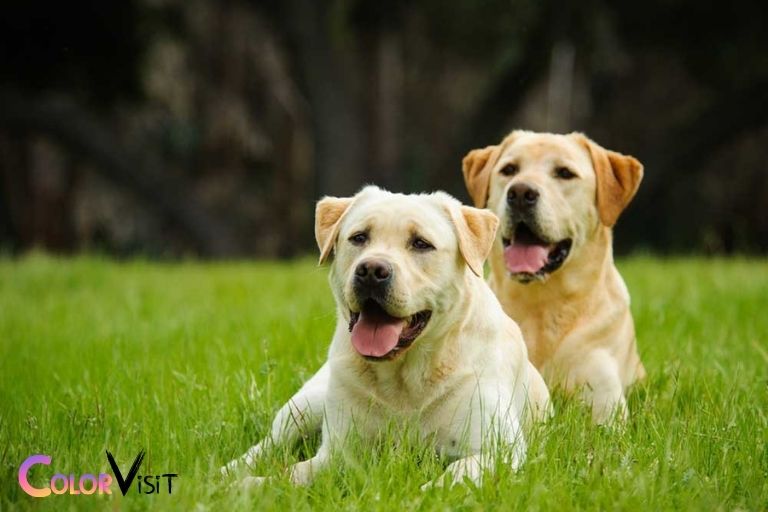What Color Puppies Will a Chocolate And Yellow Lab Have?
A chocolate and yellow Lab breeding pair will most likely produce puppies in varying shades of chocolate, yellow, and black, depending on the parents’ genetic makeup.
Labrador Retrievers have two main genes that determine their coat color the B gene, which can be either B (dominant black) or b (recessive brown/chocolate), and the E gene, which can be either E (dominant for color expression) or e (recessive yellow).
The combination of these genes from both parents will determine the coat color of the puppies:
Discovering the coat colors of Labrador puppies from a chocolate and yellow pairing is a captivating genetic puzzle.
Key Takeaway
Labrador Coat Color Genetics
The coat color of Labrador retrievers is determined by a complex interplay of genetic factors. Genetic inheritance plays a crucial role in determining the coat color of Labrador puppies.
- Understanding the principles of genetic inheritance is essential for breeding strategies aimed at producing specific coat colors.
- Breeders use knowledge of dominant and recessive genes to predict the potential coat colors of puppies from specific pairings.
- By understanding the inheritance patterns of coat color genes, breeders can develop effective breeding strategies to achieve desired outcomes.
These strategies involve selecting parent dogs with specific coat color genes to increase the likelihood of producing puppies with the desired colors.
Understanding Chocolate and Yellow Lab Pairings
An understanding of breeding strategies and genetic inheritance is crucial when considering pairings of chocolate and yellow Labs.
- Breeding two chocolate Labs will always result in chocolate offspring, as chocolate is a recessive gene.
- When breeding a chocolate Lab with a yellow Lab, the puppies will all inherit one copy of the chocolate gene from the chocolate parent, resulting in a litter of all chocolate carriers.
- This means that when these carrier offspring are bred with another chocolate carrier or a chocolate Lab, they can produce chocolate puppies.
- However, when breeding two carrier Labs, there is also a chance of producing yellow puppies if both carriers pass on their yellow gene.
Understanding these pairings is essential for predicting potential coat color combinations in Lab litters.
Potential Coat Color Combinations
When considering potential coat color combinations from a pairing of a chocolate and yellow Lab, it is important to understand the genetic inheritance of coat colors and the possible outcomes in their offspring.
The following factors should be taken into account:
- Genetic Inheritance: Coat color in dogs is determined by the combination of genes they inherit from their parents. Understanding the dominant and recessive genes for chocolate and yellow coats is crucial in predicting the potential outcomes.
- Coat Color Variations: The pairing of a chocolate and yellow Lab can result in a variety of coat color combinations in their offspring, including chocolate, yellow, black, and even variations such as fox red.
- Innovative Breeding: Breeders can use genetic testing and advanced breeding techniques to predict and achieve specific coat color outcomes, providing innovative solutions for potential coat color combinations.
- Selective Pairing: Selective breeding can be utilized to enhance and refine coat color variations, contributing to the advancement of coat color genetics in Labs.
Factors Influencing Puppy Coat Colors
Understanding the genetic factors that influence coat color inheritance is crucial when predicting the potential coat colors of puppies from a pairing of a chocolate and yellow Lab. Inherited traits play a significant role in determining the coat colors of the offspring.
When breeding two Labs of different coat colors, the combination of their genetic makeup can lead to various outcomes.
The table below illustrates the potential coat color combinations resulting from breeding a chocolate and yellow Lab:
| Chocolate Lab | Yellow Lab | Potential Coat Colors of Offspring |
|---|---|---|
| BBEE | bbEE | Black |
| BBEE | BbEe | Black, Chocolate |
| BbEe | bbEE | Black, Chocolate |
| BbEe | BbEe | Black, Chocolate, Yellow, Fox Red |
Understanding these genetic combinations can help predict the potential coat colors of the puppies.
Tips for Recognizing Color Patterns
To recognize color patterns in Labrador puppies, it is essential to observe their coat development over time.
Here are some tips for recognizing color patterns in Labrador puppies:
- Color Inheritance: Understand the genetic principles behind color inheritance in Labradors. Factors such as dominant and recessive genes play a crucial role in determining the coat color of the offspring.
- Coat Pigmentation: Pay attention to the pigmentation of the coat as the puppies grow. The development of pigmentation in the nose, eye rims, and paw pads can provide insights into the eventual coat color.
- Observation: Regularly observe the puppies’ coat as it changes from the initial color at birth to the eventual adult coat. Take note of any subtle changes in color or markings.
- Consultation: Seek guidance from experienced breeders or veterinarians who can provide valuable insights into recognizing color patterns and predicting the potential adult coat color.
Conclusion
Predicting the coat colors of puppies from a chocolate and yellow lab pairing involves understanding the genetics of Labrador coat colors and considering potential combinations.
While it may seem straightforward, the outcome can be influenced by various factors.
Recognizing color patterns can be challenging, but it adds an element of surprise and excitement to the process.
Sometimes, the most unexpected combinations can result in the most beautiful and unique puppies.

